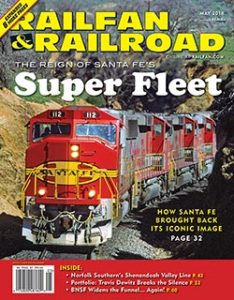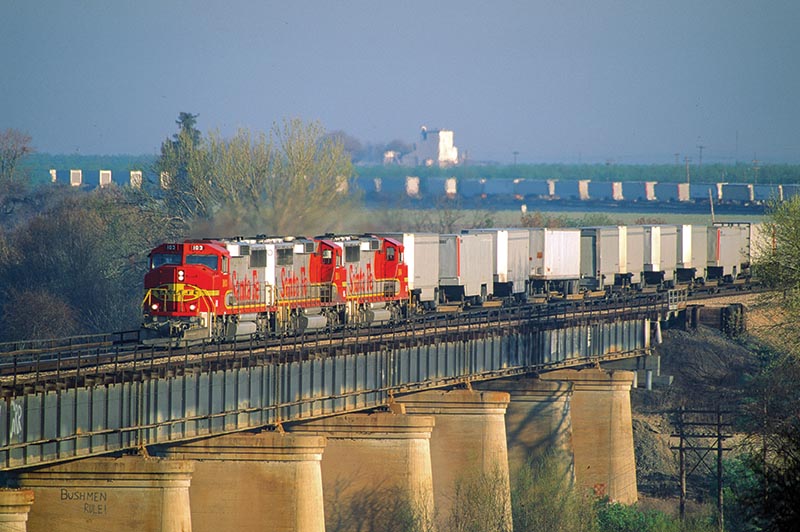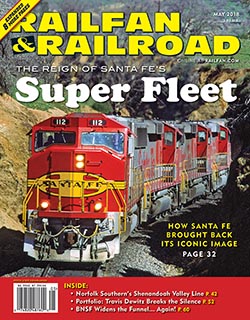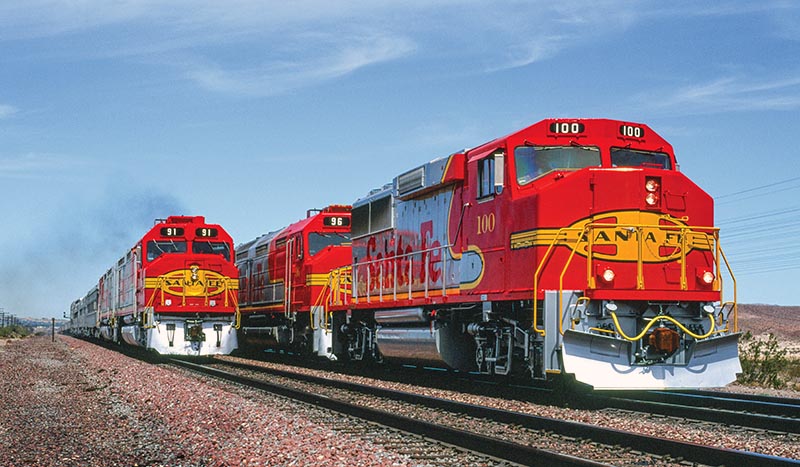 By Steve Schmollinger/photos by the author
By Steve Schmollinger/photos by the author
When designer Leland Knickerbocker created the “warbonnet” paint scheme for the Atchison, Topeka & Santa Fe, it was a stroke of marketing genius. Even more, it became one of the most easily identifiable schemes in history. It was created in 1937 to inaugurate the revamped Santa Fe Super Chief, and because of that it came to embody the classic streamliner’s premium service and allure. By the same token, when railroad president Mike Haverty resurrected the warbonnet in 1989, it was another stroke of genius, as it helped the company market its premium intermodal service to the likes of J.B. Hunt and other major shippers.
In a Chicago Tribune article dated August 14, 1989, Haverty stated, “I think that restoring the warbonnet is a way to demonstrate to our customers and the industry that we deliver quality transportation. At the same time, the warbonnet will give our employees a sense of pride in their heritage. We’re in some tough times now. Competition is tough. There is an overcapacity of all transportation. So only the fittest will survive, those that are innovators and aggressive. And we will.”

Early on a March 1991 morning, a hot 991 train roars through a huge sweeping curve at Ballico, Calif., and onto the Merced River Bridge on the first leg of its journey towards Chicago.
Haverty was as good as his word. On December 13 of the same year, the Tribune reported, “Chicago-based Santa Fe Railway and one of the nation’s largest trucking companies, J.B. Hunt Transport Services, Tuesday signed a partnership agreement to offer customized, truck-rail freight service between the Midwest and California. By working together, Santa Fe and J.B. Hunt can make deliveries between Chicago and California in three days or less, compared with four or five days through an agent, officials said. The cost would be higher than regular intermodal service but less than what a trucking company would charge for hauling freight the same distance. They estimated that the service, named ‘Quantum,’ potentially could generate up to $90 million in annual revenues for Santa Fe and J.B. Hunt.” Indeed, that deal alone was worth millions to Santa Fe, and successor BNSF Railway is still reaping the rewards.
Haverty’s “Super Fleet” variant of the warbonnet, with “Santa Fe” emblazoned in large Cooper Black lettering across the sides of his red-and-silver locomotives, not only raised the morale of his operating folks, but also elevated the profile of the railroad in the public eye. No other transportation entity in the U.S. possessed such an emblematic icon when it came to projecting an image. Much of the public was immediately aware the paint was that of the Super Chief — or at least the same as the beautiful little train that used to run around the Christmas tree — with its inherent appeal. It conjured an emotional, as well as an intellectual, response. Whether it had a direct effect on the success of the railroad can be debated, but certainly Haverty’s use of such a powerful, ingrained image increased the Santa Fe’s brand equity in the 1990s. Once the Super Fleet became ubiquitous on the property, there was little that was generic about the Santa Fe…
 Read the rest of this feature in the May 2018 issue of Railfan & Railroad
Read the rest of this feature in the May 2018 issue of Railfan & Railroad



